Quite apart from any factual errors, about which I’m not at all qualified to judge, here is what seems to me to be Meyer’s fundamental logical error IMO:
According to Darwin’s theory, the differences in form, or “morphological distance,” between evolving organisms should increase gradually over time as small-scale variations accumulate by natural selection to produce increasingly complex forms and structures (including, eventually, new body plans). In other words, one would expect small-scale differences or diversity among species to precede large-scale morphological disparity among phyla.
(Darwin’s Doubt, Chapter 2)
He illustrates this by asking us to comparing this figure, which he says is what we do see:
With this (appallingly badly drawn) one:
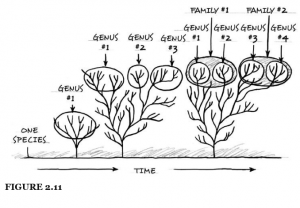 Which he claims Darwin’s theory says we ought to see.
Which he claims Darwin’s theory says we ought to see.
And he says:
The actual pattern in the fossil record, however, contradicts this expectation (compare Fig. 2.12 to Fig 2.11b). Instead of more species eventually leading to more genera, leading to more families, orders, classes and phyla, the fossil record shows representatives of separate phyla appearing first followed by lower-level diversification on those basic themes.
Well, of course it does, Dr Meyer! You have just, in Chapter 2 of your fat book made an absolutely fundamental error of understanding of the entire principle of phylogenetics and taxonomy. No, of course you wouldn’t expect phyla to follow “lower-level diversification on those basic themes”. How could it possibly? And how could you possibly so fundamentally misunderstand the entire point of Darwin’s tree and its relationship to the nested hierarchies observe by Linnaeus?
All branching events, in Darwin’s proposal, whether the resulting lineages end up as different phyla or merely different species, start in the same way, with two populations where there once was one, and a short morphological distance between them. It is perfectly true that the longer both lineages persist for, the greater the morphological distance will become. But that isn’t because they started different, or because the phyla come later. It’s because what we call phyla are groups of organisms with an early common ancestor, whose later descendents have evolved to form a group that has a large morphological distance from contemporary populations who descended from a different early common ancestor.
So when a phylum, or a class, or even a kingdom first diverges from a single population into two lineages, the “morphological distance” from the other lineage will be very short. We only call it a “phylum” because eventually, owning to separate evolution, that distance becomes very large.
I’ve amended the drawings in the book as below, and, instead of labeling the trees by what a contemporary phylogeneticists might have called them, I’ve called each tree a phylum, and I’ve drawn round the organisms that constitute various subdivisions of phyla in colours from orange to green to represent successive branchings. Rather than the little bunch of twigs marked “families” by Meyer, I’ve indicated the entire clade for each subdivision, or tried to.
In Meyer’s version, he called the early sprout “ONE SPECIES”, which a contemporary phylogeneticist (Dr Stephen Chordata perhaps) would have called a “species”. But by the time of the next tree (which I think is supposed to incorporate the first), and Dr Chordata’s distant descendent comes along, she may call it an entire “genus”, and become rather more interested in the “species” that she observes it contains. Move along one to the next tree on Meyer’s time-line and an even more distantly descendent will call the whole tree a “family” containing “genera” and “species”. What was a “genus” to her great^10 grandmother will be several genera to her, and so on. And with each multi-generation of palaeontologist, the descendents of what were close relations in her ancestral palaentologist’s day are now separated by a wide “morphological distance.
So of course, if we look at the fossil record as these speciation-events were happening and try to categorise the organisms in terms of their modern descendents, we will find a great number of different phyla, and far fewer species. Of course they have different body plans, because they lived at a time when many different lineages from the first populations of rather amorphous multi-cell colonies were still around, some with not much symmetry, some with bilateral symmetry, some with five-fold symmetry, and many that didn’t go very far and left no extant lineages. Because of course Meyer also forgets the big extinction events, which are the other part of the answer to why one particular branch “exploded” while the others were never seen again. It’s even in his terrible Figure 1.11. Which he may not have been responsible for drawing, but he should at least have looked at.
ETA: the other drawing, fixed:
Another extraordinary example of Meyer’s complete failure to understand what a clade is, or that the words “phyla” and “class” refer to clades. Coloured emendations are mine (orange/red for Meyer’s “phyla”, blue for Meyer’s “class”):
I’d have expected an urbane, Cambridge-educated guy like Meyer to know the [ETA: spot the erroneous] singular of “phyla” but that’s minor compared to his crashing howler of an attempt to demonstrate what the term means.
ETA:3 Note: As Mung has pointed out, Meyer shows that he does know the singular of “phyla”, he just doesn’t get it correct it in this particular diagram. However, as I have said elsewhere (and above), this error is minor compared with the howler of including only a group of of descendents in his circled “phyla”, not the whole branch, which as I’ve said, undermines his entire argument.

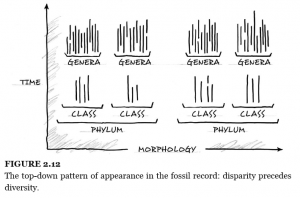
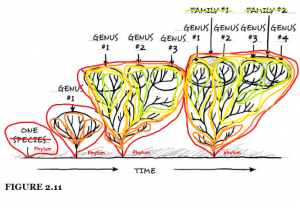
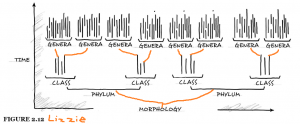
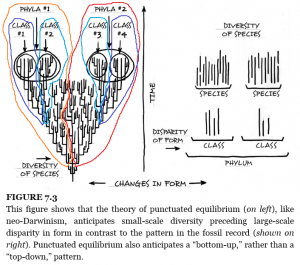
The Sensuous Curmudgeon’s blog has just directed attention to White WTJ, Zhong B, Penny D (2013) Beyond Reasonable Doubt: Evolution from DNA Sequences. PLoS ONE 8(8): e69924. doi:10.1371/journal.pone.0069924
By coincidence, this is related. They say in their conclusions.
This is the very basic creationist misunderstanding. It is what leads them to “you get microevolution but not macroevolution.”
Of course, changes at the tip of a tree only have a small effect. But change the shape of a tree when it is a freshly sprouted seedling, and you can work wonders. Horticulturists know this, but creationists don’t. I like this horticultural analogy, which illustrates the issue very well.
Creationists are quite incapable of understanding this. Their religion depends on their not understanding.
Me too. We should be having more evolutionary examples from the plant kingdom! Calling Art Hunt!
The point about extinction is important. Species can sometimes diverge rapidly. And some of those divergent lineages can later go extinct. If I see the ancestors of what later are to be two phyla, they will might not be as different as their descendants are later. But if you also count, in the initial assessment, some other early species whose descendants later go extinct, the total diversity might shrink. There is not one simple expectation. It sounds as if Meyer said there was.
Coincidence that the word “clade” is derived from the Greek “branch”?
I don’t think so.
Lizzie, do you mean that the life tree should look like this?
Multicell-colonies
……………………………………………………………………………………………………………………………
not symmetry radial symmetry bilateral symmetry others not known
Instead of these?
Multicell-colonies
……………………..not symmetry
…………………………………..radial symmetry
………………………………………………..bilateral symmetry
Yes, if I’m understanding you correctly. I’d expect that once radial symmetry got going in a lineage that lineage would continue separately from a lineage in which bilateral symmetry got going.
And that early on, a microbial colony that tended to form radial symmetry would still look pretty similar (“morphologically close”) to one that tended to form bilateral symmetry, or some other kind, but that as the two lineages diverged, the morphological distance would grow.
From the OP:
But not THE FACTS!
Elizabeth, you’ve just criticized Meyer for making a factual error while at the same time claiming you are “not at all qualified to judge” any errors of fact.
Mung, you have a boatload of questions to answer about the lies by omission Meyer made in his book.
As a Lover Of Truth I’m sure you’re busily preparing your explanation for all the data Meyer skipped, right?
Neil Rickert:
Alan Fox:
I’m guessing that you don’t understand the historical connection between horticultural studies and the fixity of species. Sure, more plant studies!
Linnaeus never studied plants.
Joe Felsenstein:
But having not read the book, you wouldn’t know.
Please explain the connection between horticultural studies and the fixity of species. With citations from mainstream texts/journals, please. No quotes copied from ID sites, pretty please.
thorton:
You’ve read it then? At last count, of all the alleged “skeptics” and “critics” here at TSZ, only Elizabeth has read it. Pretty sad.
So you either want me to respond to people who have not even read the book or you want me to respond to people who claim to have read it but who are not actually here to argue against it. That about sum it up, thorton?
The Changing Role of the Embryo in Evolutionary Thought
Elizabeth:
One would expect that if they start out as different phyla they would end up as different phyla. So let’s toss that out as a non-starter.
So if they start out a different species and end up as different phyla, how does that fit Darwin’s tree? May as well say they start out as different phyla.
So here’s what we are left with:
So let’s say we start with one species (the common ancestor), and it diversifies, and as time passes the differences become different enough that the ancestors are classified as different families, and then the differences become great enough that they are classified as different genera, and then the differences become great enough that they are classified as different classes …
That’s Darwinism. In Darwinism, divergence precedes disparity. As a species diverges over time, the descendants become disparate enough that they are classified as separate phyla.
But in the fossil record, particularly in the Cambrian, disparity comes first, then divergence. Where is he evidence of divergence preceding disparity, which is what the Darwinian theory requires?
thorton:
Asked and answered in the “Darwin’s Doubt” thread. So now you’re just trolling.
Meyer is not a young earth creationist. Do you have any evidence whatsoever to offer that he is? (He isn’t.)
Do you have any evidence whatsoever to put forth that would demonstrate that Meyer ignores the history of life before the Cambrian? (He doesn’t).
If you had read the book, you would know both of these facts.
So you can’t provide the evidence I’ve requested, because it doesn’t exist. Unless and until you can, welcome to the ignore list.
At least some of it is in the so-called “small shelly fauna” of the Precambrian era. You know, all that data Meyer skipped in DD either through incompetence or deliberate deceit.
The Cambrian Conundrum: Early Divergence and Later Ecological Success in the Early History of Animals
Abstract: “Diverse bilaterian clades emerged apparently within a few million years during the early Cambrian, and various environmental, developmental, and ecological causes have been proposed to explain this abrupt appearance. A compilation of the patterns of fossil and molecular diversification, comparative developmental data, and information on ecological feeding strategies indicate that the major animal clades diverged many tens of millions of years before their first appearance in the fossil record, demonstrating a macroevolutionary lag between the establishment of their developmental toolkits during the Cryogenian [(850 to 635 million years ago (Ma)], and the later ecological success of metazoans during the Ediacaran (635 to 541 Ma) and Cambrian (541 to 488 Ma) periods. We argue that this diversification involved new forms of developmental regulation, as well as innovations in networks of ecological interaction within the context of permissive environmental circumstances.”
Mung,
I want you to answer a question with regard to a comment you made in the other thread. No book necessary. You quote-mine Louis Agassiz who died 140 years ago. Answer the question. Does science have more/newer/better data/theoretical-knowledge today than it had 140 years ago? YES or NO.
Yet he managed to come up with a classification based on details of their flowers.
And
link
You’d be right in assuming I don’t know where you are going with this. Fixity of species appears to be an outdated concept that lingers in Creationist circles. Phlogiston was once thought to explain why things can burn. Ideas change. Horticulture today relies on the malleability of plants to selective breeding. The range and diversity of new commercially important plants that have been developed from the wild cabbage is astonishing, for instance.
Mung obviously means the Creationist claims of fixity of plant species like the Hawaiian Silversword Alliance
“Silversword alliance refers to an adaptive radiation of over 50 species in the composite or sunflower family, Asteraceae. The group is endemic to Hawaiʻi, and is derived from a single immigrant to the islands. For radiating from a common ancestor at an estimated 5.2±0.8 Ma, the clade is extremely diverse, composed of trees, shrubs, subshrubs, mat-plants, cushion plants, rosette plants, and lianas”
Mung, right on top of the latest science as usual.
Some comments that contravene the game rules moved to Guano. Remember that for the purposes of discussion at this site, assume that the other posters are posting in good faith. This means that however untrue you consider a statement to be, you must assume, for the purposes of discussion, that the poster believes it to be true (and is therefore not lying).
Thanks.
I don’t know, first hand, whether he made “any factual errors” at all, although a number of people who are qualified to do so, have made a persuasive case that he did. But, as I said, I am not personally qualified to judge. However, I am capable of noting an error of reasoning, and that is what this thread is about.
Well, no. You have missed the point I was trying to make. Which is that to a (non-existent) contemporary palaentologist, they start out not as different “phyla”, but as “species”. It’s the entire resulting lineages that constitute the different phyla, the more recent generations of each will be morphologically very distant from the more recent members of the other. But that will not be the case for the ancestral populations, which will be (and are) much more similar.
Well, to say either is to misapply the terms. A phylum (or a species, or a family, or a kingdom) in Darwin’s tree consists of an entire branch of the tree, not just the twigs at the end. But clearly, when two branches “start out” they are simply neighbouring twigs. It’s only in retrospect that we call the entire branches separate “branches”, including the sub-branches and extant twigs.
Yes. But the ancestral populations of those each phyla are also classed as members of that phylum. And so, in retrospect (which is all we have) the phyla diverged before the diversity each spawned. For some reason, Meyer gets this wrong, and it undermines his entire argument.
ETA: sorry submitted before I finished then had to go off somewhere!
To complete:
In Darwin’s theory “speciation” (i.e. the bifurcation of a population into two sub-populations that henceforth evolve down separate lineages leads (sometimes, unless it is truncated by early extinction) to an entire new branch, which diversifies into many different sub-branches. If this happens early in the tree, that branch may be called a “kingdom” or “phylum” or “family”. If it happened fairly recently, it may be called a “species” or “subspecies”. the difference is not in what kind of event the “speciation” event was – they are all “speciation” events; what makes one “speciation” a new phylum and another a new “family” is simply when it occurred.
In practice we can reconstruct these befurcations from morphological (and genetic) data, because morphological (and genetic) data turn out to be distributed as a tree. Extant species can be grouped into nested hierarchies, and fossil species can be readily placed between nodes of the inferred tree, although clearly, the older the specimen, the more ambiguity there will be about just where it fits on the tree.
No, disparity doesn’t “come first” in the fossil record. Branchings into different “phyla” come, by definition, earlier than branching into different classes, orders, families, genera, etc, but at the point at which they branch they are not “morphologically distant”. Modern examplars of each phylum are morphologically more distance from those from each other phylum than from examplars within the same phylum, but ancient ones will be less distant, and if we could find the point at which two phyla first branched, they would, according to Darwin’s theory, be extremely similar, just as two species of Darwin’s finch are now extremely similar. Examine the descendents of those finches in a few billion years, and we may have radically different Somethings (we’d need a new name) of animal, which may be morphologically very remote – one might be a marine creature, one might be a flightless quadruped.
In fact, the old taxonomic idea of a series of different nesting boxes, with each grade of box size corresponding neatly to “kingdom”, “phylum”, “class”, “order”, “family”, “genus”, and “species” is seriously out of date. Some phyla are “younger” than others – branched off later, and there are far more branches than could possibly each have a different general label. But it was the insight that taxonomy did allow for nested categorisation that led Darwin to the concept of the family tree, which consists of categories only when viewed horizontally; viewed longitudinally we see continuua, albeit punctuated, and with missing data.
Meyer seems to have missed that basic insight.
Lizzie, the formatting of this post makes it hard to figure out who is saying what. Ironic, considering the topic.
I have trouble wrapping my mind around the possibility that creationists think phyla are phyla when their first member appears. Is that really what they are saying?
I think I have fixed the formatting (it was a messed up closing tag for first quote).
I expect that is standard creationism. That’s the whole thing about created kinds. And then there’s the idea that the meaning of “phylum” is part of the creation (along with all other meanings).
Ok, but if I understand you correctly this:
“Of course they have different body plans, because they lived at a time when many different lineages from the first populations of rather amorphous multi-cell colonies were still around, some with not much symmetry, some with bilateral symmetry, some with five-fold symmetry, and many that didn’t go very far and left no extant lineages.”
and this:
“And that early on, a microbial colony that tended to form radial symmetry would still look pretty similar (“morphologically close”) to one that tended to form bilateral symmetry, or some other kind, but that as the two lineages diverged, the morphological distance would grow.”
Means that the corrections you made to the figure 2.12 of the book is incorrect. Because you are saying what that figure is representing. From a population of colonies diverged independently different simmetries of animals.
Then provide a link to the answer or just C&P it here. You won’t because you can’t.
The simple fact is you never addressed the question in that thread or any other thread. You’ve consistently ignored every last question about Meyer’s claims.
petrushka,
Short answer. Yes, that is what they believe.
Sorry, and thank, Neil for editing! I must have hit submit by accident when I left for work this morning! Completed my post now.
Lizzie, does Meyer discuss clades or monophyletic groups?
Yes, he talks the talk. He just doesn’t seem to understand the implications. For example, around that Figure 2.12 I posted, he writes:
Hennig is absolutely right, of course – once a lineage has diverged, constraints are set on what can happen next (which is incidentally the counter-charge to the accusation that “Darwinism” can account for “anything” – it can’t – it predicts severe constraints), so once you’ve got a bilateral pattern in a lineage, then all subsequent variants are going to be of bilaterality; ditto for rotational symmetry.
Where Meyer then falls flat in his assumption that the difference between bilateral symmetry and rotational symmetry was a “large” difference when it first occurred. Folding a piece of paper in half isn’t terribly different to folding it in quarters. However, having folded it in half and done some more stuff to it that can only be done on a half-folded piece, it’s going to be much harder to go back, fold it in quarters, and do some stuff that can only be done to a quarter-folded piece.
So, down the line, your half-folded critters are going to resemble each other much more than they resemble the descendents of the quarter folded critters and “quarter-folding” is going to seem like a radically different “body plan” from half-folding.
But that’s not to say it was a “large change” when it first appeared.
Meyer’s sources are fine, but as he misses their point entirely, he sees a contradiction where there is none. As his drawings show.
Thanks for that.
Regarding your point about radial (I think you mean, rather than rotary) and bilateral symmetry, I seemed to recall hearing that current thinking on starfish is that radial symmetry developed from bilaterally symmetrical ancestors. A process of curling up if you will.
In turn, the deuterostomes belong to a larger group within the Animalia called the Bilateria, because they are bilaterally symmetrical with a left and a right side to their bodies. Obviously this is not true for adult echinoderms like starfish, and you may wonder what radially symmetric critters are doing in this group. The answer lies in the development of the embryo. If you were to watch an embryonic starfish develop, you would see that it begins life bilaterally, but switches to radial symmetry as it matures.
link to my sort of level of source! 🙂
ETA:
more on ancestral bilateralism
A clue to how deep their understanding is can be found in the phrase Origin of Higher Taxa.
As if the higher taxa were higher when they originated.
It seems to be a phrase from mainstream biology that was misunderstood and appropriated.
Added another annotated figure to the OP.
I wonder whether Creationists have missed the softer target in concentrating on the Cambrian period. All the hard work has been done in getting to the eukaryote. The cellular functions and apparatus are pretty much universal across all multicellular organisms. Once you get cells sticking together it is all a matter of differentiation, concentrating particular functions in particular cells, and topology. The amazing advances in evo-devo, a very new field (2000, Edward Lewis and homeotic genes in Drosophilatriggered it, I believe) throw much light on possible evolutionary pathways among bilateria. Deuterostomes are just endless variations on a theme, exercises in cell origami. The Cambrian period looks a lot less daunting in the light of evo-devo.
Getting from prebiotic chemicals to a self sustaining self-replicator does not look such a walk in the park.
It has taken me a while to appreciate the magnitude of Meyer’s ignorance over the concept of clades. No-one else seems to have picked up on this glaring error (or at least not so elegantly), Lizzie. Do you think it deserves a wider audience? Joe F might have some ideas about a guest post at PT.
At last count, 38 replies.
Replies from people who have actually read the book?
Elizabeth has read the book (I am willing to accept her word on that) and I have read the book. Anyone else? Anyone?
Yet Alan Fox accuses me of having “dropped out.”
Honest answers about the well documented ignorance and lies by omission in the book by someone who claims to want to discuss it?
ZERO
Aardvark:
I posted the quote as it appeared in the book under discussion and I posted a link to the complete article from which the quote was taken. If that’s “quote-mining,” sue me.
Come off it. I saw you posting elsewhere and said you seemed to have dropped out. So about Meyer’s apparent error in misunderstanding on clades?
Neil Rickert:
Darwinist nonsense! 😉
Of course, you are “correct”, but that’s not the entire story,
Of course, changes anywhere in Darwin’s “tree of life” only have a small effect.
What are the alternatives?
That some other mechanism, not operating today, was operating at the “root” or “branches”? Darwinism only comes into effect at the tips?
PUH LEEZE!
Regarding having read Meyer’s book, that is irrelevant to the thread topic which is Meyer’s apparent error in understanding on clades. Lizzie has provided Meyer’s illustrations. It is the illustrations we are considering.
There’s the misunderstanding, right there. Bifurcations are speciations. It is only when we look back at the whole picture can we we draw a ring around the branch and the node for all descendant species. Phyla, classes, kingdoms are convenient but somewhat outdated in evolutionary terms. The clade and the species is all we need.
Alan Fox:
You saw me posting elsewhere when? And from that you assumed I had dropped out this thread based upon what?
You come off if. Your belief that I had “dropped out” of this thread had no basis in fact. Over in the “Darwin’s Doubt” thread I was accused of “hit and run” more than once, also without any factual basis.
Got to love how all you “skeptics” here at TSZ operate.
Well, I am sorry you are so hurt by my comment. I wanted to hear what you thought about Meyer’s apparent misunderstanding about clades. Next time I give you a heads up I’ll be more careful in my choice of words.
Alan Fox:
Yes, what Meyer wrote is irrelevant, because you haven’t actually read it. Not exactly a convincing argument, but got it.
Alan Fox:
And this contradicts Meyer how? Having not read Meyer, you can’t say.
But heck, who needs to read what he wrote to be a skeptic!
[edit to correct HTML AF]
AF: Come off it. I saw you posting elsewhere and said you seemed to have dropped out.
Really?
I was just illustrating Elizabeth’s point, which is really a general point about branching processes.
Yes, a small change is just a small change. But a small change in an early branching is the parent of many later small changes. When we look at differences between phyla, we are really looking at those accumulated differences, an accumulation that began at an early branching.
The horticultural example is that the main branches of a common garden tree are the ones that formed early.